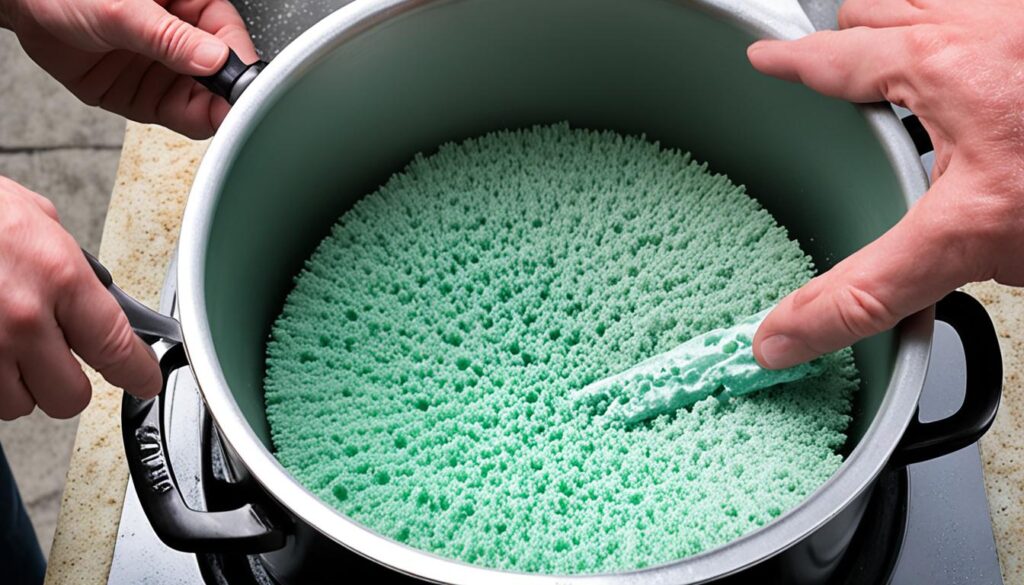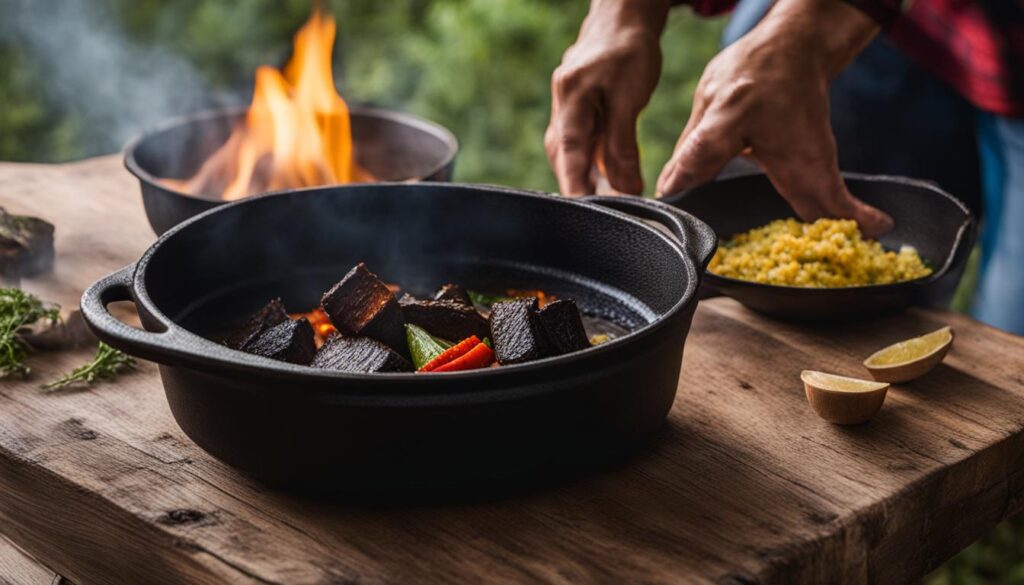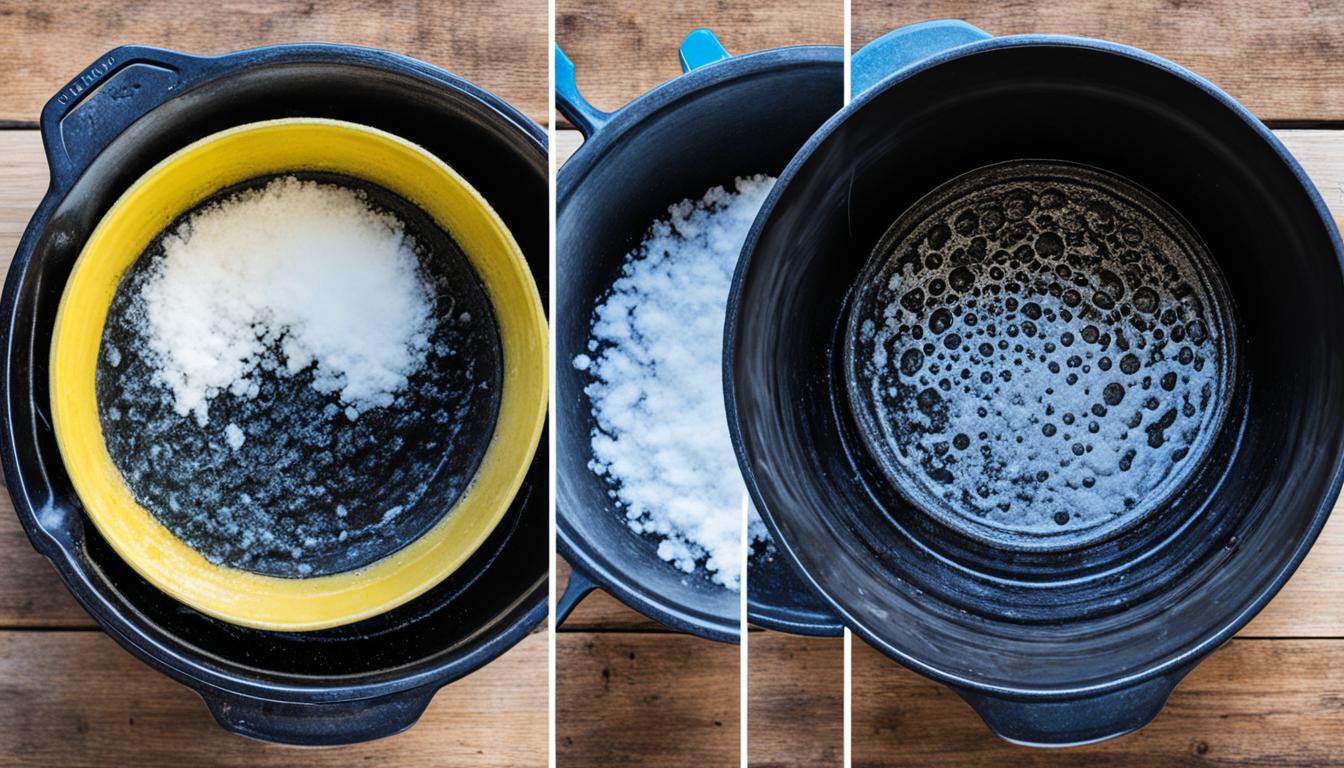Are you tired of struggling to clean your Dutch oven after cooking delicious meals? Do you want to know the best way to keep your Dutch oven looking spotless and performing at its best? We have the answers you’ve been searching for!
In this quick guide, we will share easy and effective tips for cleaning your Dutch oven, whether it’s made of cast iron or enameled cast iron. Discover the secrets to maintaining your Dutch oven’s performance, prolonging its lifespan, and ensuring a spotless finish every time.
Key Takeaways:
- Regular cleaning is essential for maintaining the performance and longevity of your Dutch oven.
- Gentle scrubbing with a baking soda paste can effectively remove stains from the exterior of the Dutch oven.
- Soaking the pot overnight in soapy water or baking soda can help loosen food residues in the interior.
- Proper seasoning and maintenance are crucial for cast iron Dutch ovens.
- Enameled cast iron Dutch ovens can be cleaned with regular dish soap and water, but avoid abrasive scrubbers.
Why Proper Cleaning is Important for Dutch Ovens
Proper cleaning of Dutch ovens is crucial for maintaining their performance and longevity. Regular cleaning helps remove food residues and prevents the buildup of grime and stains, ensuring that your Dutch oven stays in top-notch condition for years to come.
Cleaning is particularly important for cast iron Dutch ovens. As these pots are seasoned with oils or fats, regular cleaning helps eliminate any residual oils or seasonings that could turn rancid over time. This not only ensures the flavors of your dishes remain fresh but also prevents unpleasant odors from developing.
Furthermore, cleaning your Dutch oven prevents the growth of bacteria that may be present from leftover food particles. By cleaning your Dutch oven thoroughly, you reduce the risk of contamination and maintain a hygienic cooking environment.
Additionally, proper cleaning plays a vital role in maintaining the overall appearance of your Dutch oven. Whether you have a classic cast iron Dutch oven or an enameled one, regular cleaning prevents stains and discoloration, keeping your pot looking beautiful.
By dedicating a little time to clean your Dutch oven properly, you can ensure its peak performance and longevity. So, let’s dive into the best practices and care instructions for maintaining the cleanliness of your Dutch oven!
“Regular cleaning helps remove food residues and prevents grime buildup, ensuring that your Dutch oven stays in top-notch condition for years to come.”
The Importance of Cleaning for Dutch Oven Maintenance
Cleaning is not just about keeping your Dutch oven looking good; it’s also crucial for proper maintenance. Failure to clean your Dutch oven regularly can lead to stubborn stains, burnt-on food, and even the deterioration of the cooking surface.
For cast iron Dutch ovens, regular cleaning helps prevent rust and maintains the seasoning of the pot. Proper maintenance of the cast iron surface extends its lifespan and ensures optimal heat distribution for cooking.
On the other hand, enameled cast iron Dutch ovens require cleaning to prevent the buildup of food residues that can damage the enamel coating over time. By cleaning the pot after each use, you can preserve the integrity of the enamel surface and prevent chipping or peeling.
By understanding the importance of proper cleaning and maintenance, you can keep your Dutch oven in excellent condition and enjoy its benefits for years to come.
Cleaning the Exterior of Your Dutch Oven
To keep your Dutch oven looking pristine, it’s important to regularly clean the exterior. Here are some easy and effective methods to remove stains and restore its original shine.
Gentle Scrubbing with Baking Soda Paste
Start by creating a paste using baking soda and water. The abrasive nature of baking soda makes it ideal for tackling tough stains without scratching the enamel surface of your Dutch oven.
Gently scrub the exterior of the Dutch oven using a non-abrasive sponge or cloth. Avoid using steel wool or harsh scrubbers that can damage the enamel coating.
Removing Stubborn Stains
For stubborn stains that don’t budge easily, you can leave the baking soda paste on the affected area for a few minutes before rinsing it off. This allows the paste to penetrate and break down the stains, making them easier to remove.
Restoring the Original Shine
After cleaning, rinse the Dutch oven thoroughly to remove any residue. Dry it with a clean cloth or let it air dry. This gentle cleaning method will not only remove stains but also restore the exterior of your Dutch oven to its original sheen, keeping it looking brand new.
By regularly cleaning the exterior of your Dutch oven using these easy methods, you can maintain its appearance and prolong its lifespan. Don’t forget to also clean the interior of your Dutch oven for optimal performance.
Cleaning the Interior of Your Dutch Oven
The interior of a Dutch oven is typically coated with enamel or is naturally nonstick. Proper cleaning of the interior is essential to remove food residues and maintain its cooking performance. Here are some easy dutch oven cleaning methods to help you deep clean the interior and keep your Dutch oven in perfect condition.
To start, soak the Dutch oven in hot water with a bit of soap or baking soda overnight. This will help loosen any food residues that have adhered to the bottom of the pot. For stubborn stains or burnt-on food, you can try boiling water with a pinch of baking soda in the pot and letting it soak. Alternatively, you can use Bar Keepers Friend powder, which is known for its effectiveness in removing stubborn stains. Just make sure to follow the product instructions and rinse thoroughly after use.

When cleaning the interior of your Dutch oven, it’s important to avoid using steel wool or abrasive scrubbers, as they can damage the enamel coating. Instead, use a soft sponge or cloth to gently scrub the interior. This will prevent scratches and preserve the nonstick or enamel coating of your Dutch oven.
Pro Tip: For easier cleaning, try to remove any food residues as soon as possible after cooking. This will prevent them from becoming baked on and difficult to remove.
Cleaning the interior of your Dutch oven regularly will ensure that it performs optimally and prevents any unwanted flavors or odors from transferring to your dishes. By following these easy dutch oven cleaning methods, you can keep your Dutch oven in pristine condition and enjoy delicious meals for years to come.
Seasoning and Maintenance Tips for Cast Iron Dutch Ovens
If you have a cast iron Dutch oven, proper seasoning and maintenance are essential to ensure its longevity and optimal performance. Here are some tips to keep your cast iron Dutch oven in great shape:
- Season your Dutch oven: Before using a new cast iron Dutch oven, it’s important to season it. Start by coating the interior and exterior surfaces with cooking oil, such as vegetable oil or flaxseed oil. Make sure to cover the entire surface, including the lid. Then, preheat your oven to about 375°F (190°C) and place the Dutch oven upside down on the oven rack. Let it bake for about an hour, or until the oil has been absorbed and the surface appears glossy. This process helps create a natural, nonstick layer that protects the cast iron from rusting and enhances its cooking capabilities.
- Clean after each use: After cooking with your cast iron Dutch oven, wipe it down with a dry paper towel to remove any food residues or excess oil. This helps prevent the buildup of sticky residue and keeps the surface clean. If necessary, use a moist paper towel to remove stubborn residues or stuck-on food particles.
- Keep it dry: One of the most important maintenance tips for cast iron Dutch ovens is to keep them dry. Moisture can cause rusting and damage the seasoning. After cleaning, make sure to thoroughly dry the Dutch oven with a towel or by placing it on a stovetop over low heat until completely dry.
- Re-season periodically: Over time, the seasoning on your cast iron Dutch oven may wear off or become less effective. To maintain its nonstick surface and prevent rusting, it’s recommended to re-season your Dutch oven periodically. Simply repeat the seasoning process by applying a thin layer of cooking oil and baking it in the oven as mentioned above.
By following these simple tips, you can keep your cast iron Dutch oven in excellent condition and enjoy its excellent cooking performance for years to come!

Maintenance Tips for Cast Iron Dutch Ovens:
Here are some additional maintenance tips to keep in mind:
- Never use soap or harsh detergents to clean your cast iron Dutch oven, as they can strip away the seasoning. Instead, use hot water and a stiff brush or sponge to remove any residues.
- Avoid using metal utensils or abrasive scouring pads, as they can scratch the surface of your Dutch oven. Opt for wooden, silicone, or nylon utensils for cooking and cleaning.
- If your cast iron Dutch oven develops rust, you can remove it by scrubbing the affected area with steel wool or a scrub brush. Once the rust is removed, make sure to re-season the Dutch oven to restore its protective coating.
- Store your cast iron Dutch oven in a dry place with the lid slightly ajar to allow air circulation and prevent moisture buildup.
By following these maintenance tips, you can ensure that your cast iron Dutch oven remains in top condition and serves you well in preparing delicious meals.
Tips for Cleaning Enameled Cast Iron Dutch Ovens
Enameled cast iron Dutch ovens are a popular choice for their durability and versatility in the kitchen. Cleaning these ovens is relatively easy, and they do not require the same level of maintenance as bare cast iron ones. Here are some helpful tips for keeping your enameled cast iron Dutch oven spotless:
1. Use Regular Dish Soap and Water
When it comes to cleaning enameled cast iron Dutch ovens, you can rely on regular dish soap and water. Simply fill the pot with warm soapy water and gently scrub the interior and exterior using a soft sponge or cloth. Avoid using abrasive scrubbers or brushes that can scratch the enamel finish.
2. Be Mindful of Tough Stains
If you have stubborn stains or burnt-on food in your enameled cast iron Dutch oven, there are a couple of effective cleaning methods you can try. One option is to create a paste using baking soda and water. Apply the paste to the stained areas, let it sit for a while, and then gently scrub with a sponge. Alternatively, you can fill the pot with a mixture of hot water, dish soap, and baking soda and let it soak overnight. This will help loosen the stains and make them easier to remove.
3. Avoid Abrasive Scrubbers
To preserve the enamel finish of your Dutch oven, it’s important to avoid using abrasive scrubbers or harsh cleaning tools. These can scratch or damage the enamel, compromising the appearance and performance of your pot. Stick to soft sponges, non-abrasive cloths, or nylon brushes for cleaning.
4. Dry Thoroughly
After cleaning your enameled cast iron Dutch oven, make sure to dry it thoroughly before storing it. Excess moisture can lead to rusting or damage the enamel coating. Use a clean, dry cloth or paper towel to remove any residual water, and allow the pot to air dry completely before putting it away.
With these cleaning tips, you can ensure that your enameled cast iron Dutch oven remains in great condition for years to come. Cleaning regularly and using gentle cleaning methods will help maintain the beauty and functionality of your Dutch oven, allowing you to enjoy delicious meals and create lasting memories in the kitchen.
Conclusion
Cleaning a Dutch oven doesn’t have to be a difficult task. With the right techniques and methods, you can easily keep your Dutch oven performing at its best and looking brand new. Whether you own a cast iron or enameled cast iron Dutch oven, regular cleaning and proper maintenance are key to its longevity and cooking capabilities.
By following the easy and effective cleaning tips provided in this guide, you can ensure that your Dutch oven remains spotless and ready for your next delicious meal. Remember to use gentle yet effective cleaning solutions, such as baking soda paste, and avoid using abrasive materials that can scratch the surface. For stubborn stains or burnt-on food, try soaking the pot in a mixture of hot water, dish soap, and baking soda overnight to loosen them before cleaning.
Proper care and maintenance of your Dutch oven will prevent the buildup of grime, stains, and bacteria, preserving its performance and appearance for years to come. Whether you’re an avid home cook or a beginner in the kitchen, these easy Dutch oven cleaning methods will make the task a breeze, giving you more time to focus on creating delicious meals with your trusty Dutch oven.
